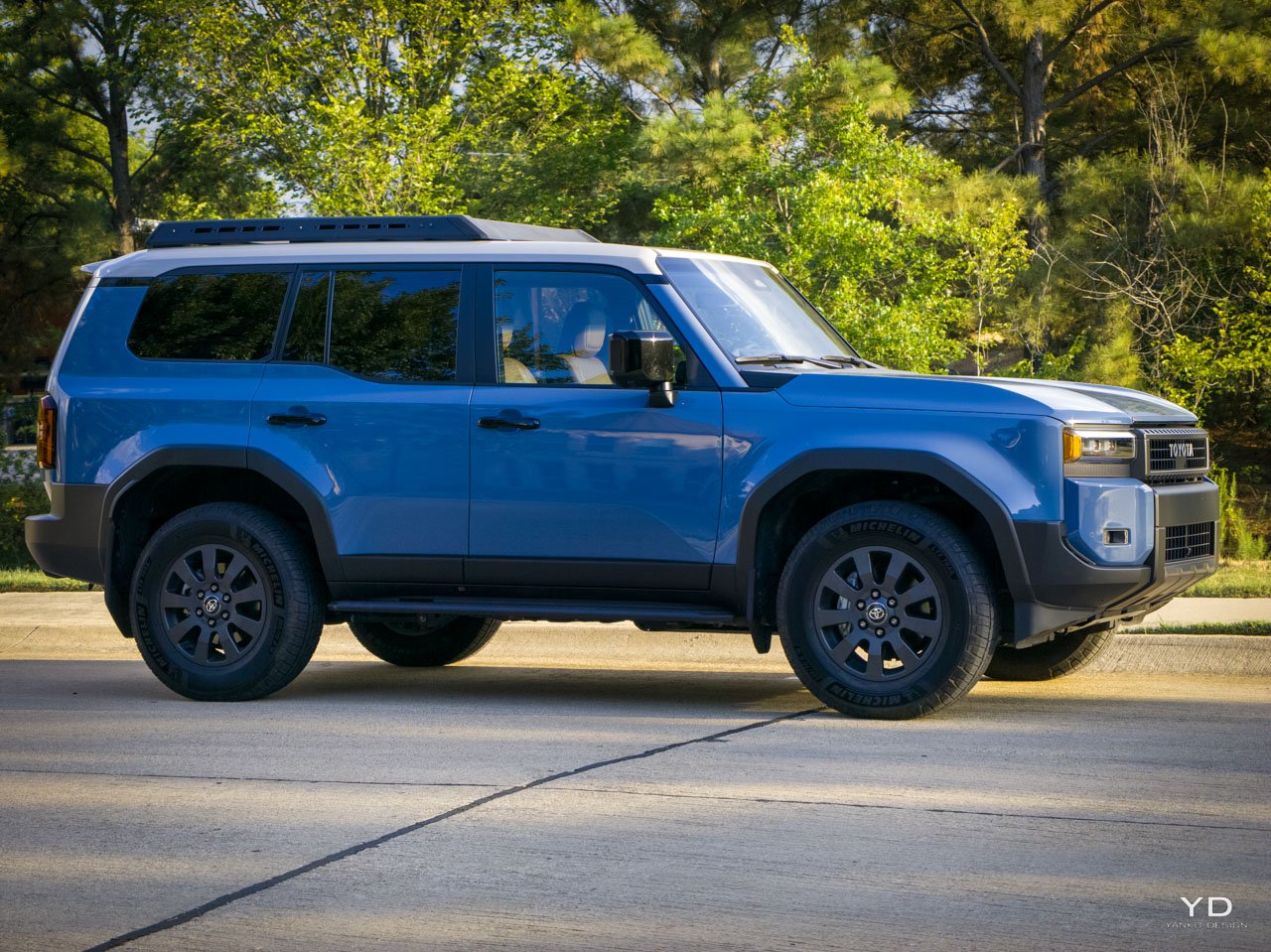September 2025 is turning out to be an exceptional month for automotive design, showcasing vehicles that push boundaries across every segment. From rugged off-road capabilities reimagined for modern adventures to luxury concepts that redefine comfort, this month’s standout designs demonstrate how manufacturers balance heritage with innovation while solving real-world problems.
The automotive landscape continues evolving at breakneck speed, with designers creating vehicles that satisfy increasingly diverse consumer demands while meeting stringent environmental regulations. These five vehicles represent the pinnacle of automotive design thinking, each addressing unique challenges while advancing their respective brand identities in bold new directions that surprise and inspire.
1. 2025 Toyota Land Cruiser
The 2025 Toyota Land Cruiser represents evolutionary design mastery, proving iconic vehicles can honor heritage while embracing contemporary functionality. Toyota’s design team crafted a vehicle that immediately communicates capabilities while addressing real-world durability concerns actual off-road enthusiasts face. The heritage grille sits proudly between high-mounted headlights, strategically clustered toward the center where trail damage protection matters most.
The split bumper design deserves particular praise because it allows corner section replacement rather than complete assembly swaps when inevitable scrapes occur. Triple beam LED headlights provide exceptional visibility while maintaining the purposeful, no-nonsense aesthetic defining Land Cruiser DNA. From the profile, squared wheel arches and tucked lower door panels tell the capability story, while the deliberately lower beltline offers commanding sight lines.
What we like
Split bumper design reduces long-term ownership costs through practical repairability features.
Lower beltline provides superior visibility compared to contemporary SUV designs.
What we dislike
The conservative design approach may not attract style-conscious buyers seeking modern aesthetics.
Traditional proportions limit aerodynamic efficiency compared to car-based crossover alternatives.
2. Vision Xpectra
The Vision Xpectra concept, unveiled at the Munich Motor Show 2025, represents a fascinating exploration of ultra-luxury transportation freed from traditional constraints. Measuring 19 feet long with a 3,450 mm wheelbase, it exceeds even the Rolls-Royce Phantom while maintaining a dramatically low 1,405 mm height. Designer Nader Faghihzadeh’s “Energy Force” language manifests through clean lines and powerful shapes flowing organically across surfaces.
The panoramic glass roof extends front to rear, creating an uninterrupted canopy, transforming the interior into a mobile conservatory. Split LED headlights run along bumper profiles before merging at lower extremes, while secondary sets flow over the hood and fenders. The emotional intelligence system uses soft body panel illumination to greet occupants, transforming the vehicle from a passive object into an active participant in a luxury experience.
What we like
Emotional intelligence features create unprecedented personalized luxury experiences through innovative technology integration.
Dimensional proportions establish a commanding presence while maintaining an elegant profile and sophisticated stance.
What we dislike
Extreme length limits practical usability in urban environments and standard parking situations.
Concept-level features may not translate effectively to production reality or prove financially viable.
3. Polestar 5
The Polestar 5 represents perhaps the most architecturally sophisticated vehicle in this collection, built upon the brand-new Polestar Performance Architecture, fundamentally reimagining electric vehicle construction. The bespoke platform employs bonded and riveted aluminum techniques typically reserved for limited-production British sports cars rather than mass-produced vehicles. This approach provides extreme torsional rigidity while maintaining relatively light weight, creating a solid, responsive feel enthusiast drivers crave.
The vehicle’s silhouette achieves a remarkable 0.24 drag coefficient through careful aerodynamic attention. Retractable door handles eliminate wind-catching protrusions while meticulously sculpted bodywork guides airflow efficiently over the low, wide form. The absence of traditional rear windows represents bold design thinking prioritizing aerodynamic efficiency over conventional expectations. Clean surfaces and purposeful lines create visual cohesion without resorting to overwrought complexity.
What we like
Advanced aluminum construction provides exceptional structural rigidity while supporting sustainability goals through recycled materials.
Class-leading aerodynamics directly enhance range and efficiency performance through intelligent design solutions.
What we dislike
Lack of a rear window may create practical visibility and safety concerns for everyday driving situations.
Premium construction techniques likely result in significantly higher production costs, affecting accessibility.
4. Volkswagen ID. Cross Concept
The Volkswagen ID. Cross Concept demonstrates how mainstream manufacturers inject personality and innovation into accessible electric vehicles without resorting to gimmicks or cost-prohibitive features. Built on VW’s proven MEB Plus platform, this concept achieves the challenging balance between approachable pricing and genuine desirability. The front design adopts a “friendly” appearance, differentiating it from aggressive contemporary SUVs through narrow LED headlights and a smile-like grille.
Smooth surfaces reflect minimalist, futuristic styling while maintaining clean proportions, defining successful Volkswagen designs. Heritage elements, particularly louvered rear windows recalling the iconic Microbus, demonstrate how brands can honor history while moving confidently into electric futures. Compact dimensions measuring 4,161 mm position the ID. Cross in the small SUV sweet spot with 21-inch wheels providing a sturdy yet sleek stance.
What we like
Heritage design elements create emotional connections while maintaining modern functionality and brand recognition.
Competitive pricing makes the electric transition accessible to a broader consumer base seeking affordable sustainability.
What we dislike
The conservative approach may struggle to differentiate in an increasingly crowded EV market segment.
Limited range compared to premium electric competitors may restrict long-distance usability for some buyers.
5. McLaren Marauder Concept
The McLaren Marauder concept by artist Quirkpixel represents perhaps the most audacious design exploration in this collection, imagining supercar DNA unleashed from perfect pavement constraints. This isn’t merely a McLaren with a lift kit but a ground-up exploration of how ultimate driving experiences translate to environments beyond racetracks. The concept maintains McLaren’s signature cab-forward, mid-engine proportions while adopting Baja trophy truck ground clearance and muscular stance.
While Porsche explored similar territory with the 911 Dakar and Lamborghini with the Huracán Sterrato, the Marauder takes the philosophy further by baking off-road capability into fundamental design rather than adding it as an afterthought. The two-door configuration represents a deliberate rejection of practical compromises, positioning this as a pure driving machine. The design suggests power-sliding through gravel hairpins with screaming V8 engines, creating experiences that conventional supercars cannot provide.
What we like
Maintains authentic supercar proportions while adding genuine off-road capability for unique driving experiences.
Opens new experiential possibilities for high-performance vehicle ownership beyond traditional track environments.
What we dislike
The two-door configuration severely limits practical utility compared to SUV alternatives for everyday use.
Concept nature means actual production and pricing remain entirely speculative without confirmed development plans.
The Future Looks Bright: Design Innovation Across Every Segment
September 2025’s automotive design highlights demonstrate the industry’s increasing sophistication in balancing diverse customer demands with technical constraints. From Toyota’s respectful evolution of an icon to Volkswagen’s accessible innovation and McLaren’s boundary-pushing concept work, these designs prove that creativity and functionality coexist across market segments. Each vehicle addresses specific user needs while advancing brand identity in meaningful directions.
The future of automotive design continues to be surprising and inspiring, with manufacturers finding new ways to honor heritage while embracing technological advancement. These five designs represent different approaches to common challenges, showing there’s no single path to success in contemporary automotive design. Whether prioritizing capability, luxury, efficiency, accessibility, or pure excitement, each vehicle demonstrates thoughtful solutions to real-world problems while maintaining distinctive character.
The post 5 Best Automotive Designs Of September 2025 first appeared on Yanko Design.

